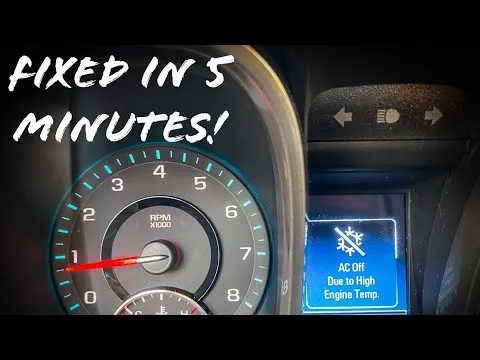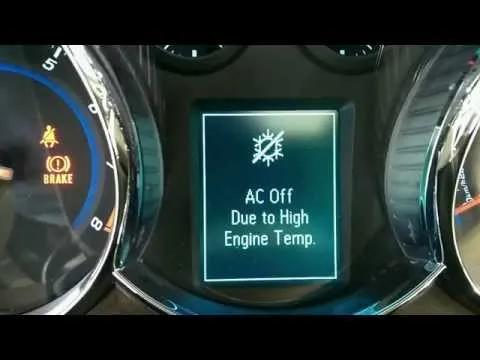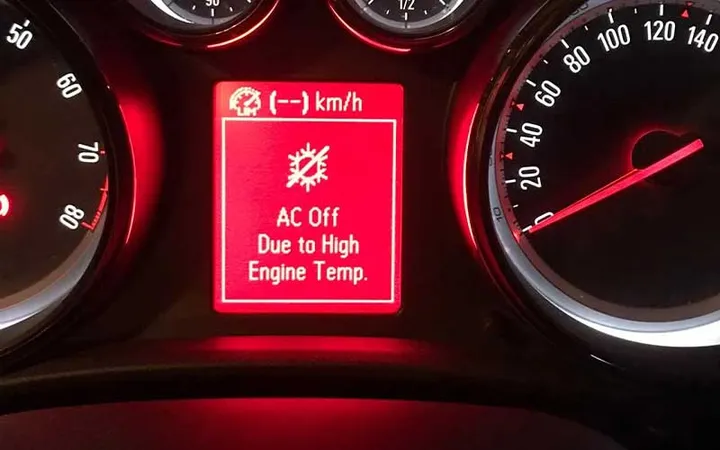


Having your car overheat and then not start can be a frustrating and potentially costly experience. When an engine overheats, it can cause significant damage to various components, leading to a situation where the engine cranks but won't start. Understanding the potential causes and taking appropriate actions is crucial to prevent further damage and get your vehicle back on the road.

Before we dive into the nitty-gritty of the "AC off due to high engine temp" warning, let's take a moment to appreciate the intricate cooling system that keeps your engine running at optimal temperatures. This system is a complex network of components:
| Component | Function |
|---|---|
| Radiator | Dissipates heat from the coolant as it circulates through the engine |
| Water Pump | Ensures continuous flow of coolant |
| Thermostat | Regulates the temperature by controlling the coolant's flow rate |
| Sensors | Monitor the temperature and relay information to the engine's computer |
| Hoses | Connect the various components of the cooling system |
The radiator acts as the heart of the cooling system, while the water pump ensures this continuous flow of coolant. The thermostat regulates the temperature, and sensors strategically placed throughout the system monitor the temperature and relay this information to the engine's computer, which can then make adjustments or trigger warnings as necessary.

Now, let's explore the most common causes that can lead to the dreaded "AC off due to high engine temp" warning:
Low Coolant Level
Clogged Radiator
Faulty Radiator Fan
Damaged Thermostat
Faulty Temperature Sensors
Bad Temperature-Sensing Circuit
Blown Head Gasket
This is often the simplest and most common issue. If the coolant level is low, the engine cannot be properly cooled, leading to overheating. Coolant can become depleted due to:
Leaks
Evaporation
Lack of regular refilling
Over time, radiators can become clogged with dirt, debris, or even scale buildup, hindering their ability to effectively transfer heat from the coolant to the air. This can cause the engine to overheat, triggering the warning.
The radiator fan plays a crucial role in drawing air through the radiator to aid in cooling. If the fan fails to operate, the radiator cannot dissipate heat efficiently, leading to overheating.
The thermostat is responsible for regulating the flow of coolant through the engine. If it becomes stuck in the open or closed position, it can disrupt the cooling system's ability to maintain the proper temperature, causing the engine to overheat.
Your engine relies on various temperature sensors to provide accurate readings to the computer. If these sensors malfunction or provide incorrect data, the computer may misdiagnose an overheating condition and shut off the AC as a safety measure.
Even if the sensors themselves are functioning correctly, issues with the wiring or connections in the temperature-sensing circuit can lead to inaccurate readings and trigger the AC shutdown.
In more severe cases, a blown head gasket can cause coolant leaks and mixing with engine oil, leading to overheating and the AC shutdown as a protective measure.
Now that we've covered the potential causes, let's dive into the troubleshooting and diagnosis process. As a mechanic, I always recommend starting with the simplest checks first:
Check the Temperature Gauge and Coolant Level
Inspect the Radiator Hoses
Look for Coolant Leaks
Listen for the Radiator Fan
Perform a Cooling System Pressure Test
Check for Signs of a Blown Head Gasket
The first step is to visually inspect the temperature gauge and coolant level. If the coolant level is low, top it up and observe if the warning light goes off.
Feel the upper and lower radiator hoses for temperature differences. A significant temperature difference between the two hoses can indicate a faulty thermostat.
Inspect the radiator, water pump, and hoses for any signs of coolant leaks, which can contribute to low coolant levels and overheating.
When the AC is engaged, listen for the radiator fan turning on. If it doesn't, the fan or its relay may be defective.
This diagnostic test can help identify any leaks or blockages in the cooling system that may be causing overheating.
Look for white smoke from the exhaust, milky oil, or other indicators of a blown head gasket, which can be a more serious issue.
Once the root cause has been identified, it's time to roll up our sleeves and get to work. Here are some common repair procedures and maintenance tips:
| Repair | Procedure |
|---|---|
| Low Coolant Level | Refill the system to the recommended level after inspecting for and repairing any leaks |
| Clogged Radiator | Flush the system to remove debris or replace the radiator if severely clogged |
| Faulty Radiator Fan | Replace the radiator fan motor or relay |
| Damaged Thermostat | Remove and replace the faulty thermostat, following the manufacturer's instructions |
| Faulty Temperature Sensors | Replace the coolant temperature sensor(s) or inlet temperature sensor |
| Bad Temperature-Sensing Circuit | Inspect and repair any loose connections, corrosion, or damage in the wiring |
| Blown Head Gasket | Remove the cylinder head and replace the head gasket (best done by a professional) |
Preventive maintenance is also crucial to avoid these issues in the first place:
Regularly check and maintain proper coolant levels
Flush and replace the coolant at recommended intervals
Inspect and clean the radiator periodically to prevent clogging
Replace aging or worn components like the thermostat, water pump, and radiator hoses
As with any repair, the cost can vary significantly depending on the underlying issue. Here's a general breakdown of potential costs:
| Repair | Cost Range |
|---|---|
| Replacing a coolant temperature sensor or thermostat | $100 - $300 |
| Radiator flush or replacement | $300 - $1,000 |
| Radiator fan replacement | $300 - $600 |
| Head gasket replacement | $1,000 - $2,500 (labor-intensive job) |
While these costs may seem daunting, remember that regular maintenance and addressing issues promptly can help prevent more expensive repairs down the line. It's always better to nip a problem in the bud before it escalates into a major issue.
Dealing with the "AC off due to high engine temp" warning can be frustrating, but with the right knowledge and approach, it's a problem that can be tackled head-on. As a mechanic, I've seen countless cases where a simple fix or timely maintenance could have prevented this issue altogether.
Remember, your vehicle's cooling system is a complex and vital component, and neglecting it can lead to costly repairs and potential engine damage. Stay vigilant, listen to your car's warning signs, and don't hesitate to seek professional assistance when needed.
Happy and safe driving, my friends! And remember, if you ever find yourself sweating it out with that pesky warning light, you know who to call – your friendly neighborhood mechanic!
The coolant absorbs heat from the engine and transfers it to the radiator, where it is dissipated. It also lubricates certain engine components as it circulates.
Yes, a faulty water pump that fails to circulate the coolant properly can lead to overheating and trigger the warning.
The coolant should be flushed and replaced according to the manufacturer's recommended intervals, typically every 30,000 to 60,000 miles or 2 to 5 years.
Signs of a blown head gasket include white smoke from the exhaust, milky or discolored engine oil, and coolant leaking into the engine cylinders.
In some cases, a clogged radiator can be flushed and cleaned, but if the clogging is severe or the radiator is old, it may need to be replaced.
The thermostat regulates the flow of coolant through the engine, allowing the engine to reach and maintain its optimal operating temperature.
Yes, if the temperature sensor is providing inaccurate readings to the engine's computer, it may trigger the warning as a precautionary measure.
Regular maintenance, including flushing the system and replacing the coolant at recommended intervals, can help prevent clogging from debris and scale buildup.
If the warning comes on while driving, pull over safely as soon as possible, turn off the engine, and allow it to cool down before attempting any troubleshooting or repairs.
Yes, experienced mechanics can often diagnose the cause through visual inspections, pressure tests, and other diagnostic techniques without disassembling major components initially.

Sarah isn't your average gearhead. With a double major in Mechanical Engineering and Automotive Technology, she dived straight into the world of car repair. After 15 years of turning wrenches at dealerships and independent shops, Sarah joined MICDOT to share her expertise and passion for making cars run like new. Her in-depth knowledge and knack for explaining complex issues in simple terms make her a valuable asset to our team.













